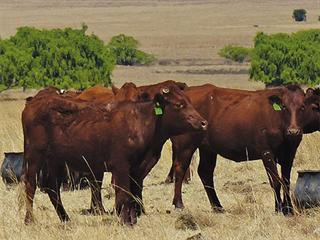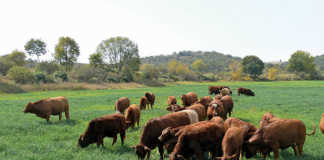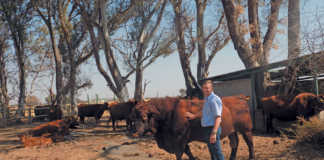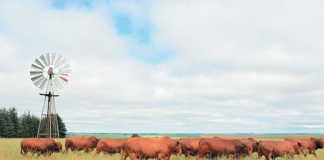
Robert Thekiso began his association with Bonsmara cattle back in 1988 when he bought his first stud bull to use on about 18 crossbred cows – the basis of his current herd. “I started by using a bull with those deurmekaar cattle,” he says, while walking among some of his 108 Bonsmara-type cows. “I’ve come a long way with the Bonsmara.” Indeed he has.
Last year his cows produced weaners with average weights of 220kg (at six to seven months) and between 230kg and 250kg (at nine months). The calving rate in his breeding herd was 90%.“If your eyes are closed, you must take the hand of a man who sees, so that he can show you the right road,” says Robert, recently named the Agricultural Research Council’s Free State Emerging Beef Farmer for 2013. He is referring to his willingness to adapt and run his beef enterprise according to commercial principles.
Small beginnings
Born in 1952, in the Bofulo area near Thaba ’Nchu, Robert watched over his family’s cattle as a boy. In 1973, he left for nearby Bloemfontein to take up a job as an electrician with the old South African Railways.His wages enabled him to begin building a small herd of cattle back in Bofulo. By 1985, the herd had grown to 18. Faced with the problem of limited grazing, he approached the then Bophuthatswana government about leasing land.
A year later, he was granted permission to lease Khumo farm. He brought 27 crossbred cattle (18 cows) to the farm, while his wife Albina started up a small shop in nearby Thaba ‘Nchu. Over the years, it became clear to Robert that the Bonsmara had become a 2013popular breed among commercial farmers in the Free State. He began looking at the breed as a source of bulls for his crossbred cattle.
“I saw that most of the white commercial farmers had Bonsmaras,” he says. “I saw, I learnt, and asked them why they liked the Bonsmara.’’ In 1988, Robert bought his first Bonsmara bull from the nearby Excelsior district for R12 000 and has purchased only Bonsmara bulls from across the central Free State ever since.In addition, over the years, he has strictly selected only the best Bonsmara-type replacement heifers. He recently purchased 40 cows and calves from the Senekal area and is keenly awaiting the effect of their genetic contribution on his herd.

Robert Thekiso, the Free State’s ARC Emerging Beef Farmer for 2013.
To accommodate them on the property, he culled a number of old cows and other undesirable animals earlier this year. Robert says that he has been consistently impressed with what the Bonsmara has brought to his herd – which today consists of well-adapted, functional and easy-calving mothers able to produce quality weaners.“The farm is a business,” he says about the true value of producing Bonsmara weaners on Khumo farm (which he eventually purchased in 1999). “I need to make money.”
Measuring performance and production
Robert stresses that his herd is a “collective production machine” that needs to generate as much income with as few inputs as possible. This means the production of quality weaners with good conformation without sacrificing the ease of calving that Bonsmaras are known for. In this regard, the measurement and recording of performance and production is critical. And institutions such as the Agricultural Research Council and Glen Agricultural College (near Bloemfontein) play an important role.Although he has the production history of all his cows and sires at his fingertips, it is the quality of the calf produced that intrigues him the most.
All calves are weighed at birth, at two months and again at weaning to manage growth and size.“A calf with a weight between 30kg and 35kg is 100% all right,” he says. “As the birth weight gets closer to 40kg, the possibility of calving problems is higher.” Heifers are put to the bull when they are about 27 months. This takes place in December and January and the cows are mated at the same time. All the females are mated at a ratio of 25 to 30 to a bull in single sire herds. The heife replacement rate is 30%, and any female animal that skips is culled.
Coping with drought
All cattle on Khumo receive a protein lick in winter and a phosphate lick in summer and are supported (along with a small flock of Dohne Merino sheep – see panel) on 60ha oats and 70ha dryland maize. Robert has plans, however, to establish 140ha of dryland Eragrostis.He says that being able to cope with the effects of drought is essential. Not only must fodder be well-managed, but a farmer has to be willing to sell animals if conditions demand it – for the sake of the herd. In 2013, for example, in a desperately dry spring, Robert reduced his herd from a little over 100 breeding females to below 70. He also sourced chicken litter, bought at either R400/t or R25/ bag from poultry farms closer to Bloemfontein.
Looking back on his farming career, Robert says that he quickly learnt that farming successfully takes 100% commitment, as well as being based on the farm – obvious facts that many farmers don’t seem to grasp. “I always tell people they wouldn’t put their money alongside the road and then go and sleep in their home,” he says.
Read: Choosing the right breed
“Why then would they leave millions of rand on their farm and go back to their home in a town? It’s stupid.” Being based on the farm is not only important for effective management; it helps to fight theft, he adds. “I’m always here on my farm – it’s very, very important,” he says. “If there are many people staying on the farms, then the tsotsis will know you are many and not see you as a soft target.”
Robert tells of an incident a number of years ago when seven armed men arrived on the farm. “They were carrying machine-guns and, since I never have more than R1 000 in my wallet, they were very angry when I could only produce R300.” Another difficulty he faces is an inability to expand his farming operations because of the current expense of land. For now, he is developing his farm by increasing his productive capacity to comfortably calve about 115 to 120 female animals.
Limited assistance
All the same, Robert is frustrated with the department of land affairs. For the past five years, he has consistently – and unsuccessfully – tried to obtain more land via the Proactive Land Acquisition Strategy. “There are a lot of farms here – white guys that want to sell. But land affairs always says it has no money,” he observes. On the other hand, he recently received assistance from the Free State department of agriculture for the first time.
This included 48 rolls of fencing material (with poles and droppers), the building of a reservoir and the overhauling of all the windmills on the farm. And the department has promised more assistance in the future. Robert feels confident about the future of his Bonsmaras, especially considering the increasing interest shown in them by his 22-year-old son Teboho.
Phone Robert Thekiso on 083 685 1757 or 071 029 9307.













